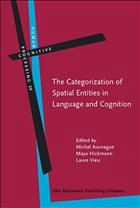Main description:
Despite a growing interest for space in language, most research has focused on spatial markers specifying the static or dynamic relationships among entities (verbs, prepositions, postpositions, case markings...). Little attention has been paid to the very properties of spatial entities, their status in linguistic descriptions, and their implications for spatial cognition and its development in children. This topic is at the center of this book, that opens a new field by sketching some major theoretical and methodological directions for future research on spatial entities. It brings together linguistic descriptions of spatial systems, formal accounts of linguistic data, and experimental findings from psycholinguistic studies, all couched within a wide cross-linguistic perspective. Such an interdisciplinary approach provides a rich overview of the many questions that remain unanswered in relation to spatial entities, while also throwing a new light on previous research focusing on related topics concerning space and/or the relation between language and cognition.
Table of contents:
- Introduction
- Part I. Spatial Entities and the Structures of Languages: Descriptive Work
- A Taxonomy of Basic Natural Entities
- On the Spatial Meaning of contre in French
- The Prepositions par and à travers and the Categorization of Spatial Entities in French
- The Linguistic Categorization of Spatial Entities
- The Expression of Semantic Components and the Nature of Ground Entity in Orientation Motion Verbs
- Part II. Spatial Categorization in Language and Cognition
- Categorizing Spatial Entities with Frontal Orientation
- Containment, Support, and Beyond
- Static and Dynamic Location in French
- Precursors to Spatial Language
- The Sources of Spatial Cognition
- Part III. Characterizing Categories of Spatial Entities: Formal Ontology
- From Language to Ontology
- The Temporal Essence of Spatial Objects
- Part-of Relations, Functionality and Dependence
- Objects, Locations and Complex Types.
Despite a growing interest for space in language, most research has focused on spatial markers specifying the static or dynamic relationships among entities (verbs, prepositions, postpositions, case markings...). Little attention has been paid to the very properties of spatial entities, their status in linguistic descriptions, and their implications for spatial cognition and its development in children. This topic is at the center of this book, that opens a new field by sketching some major theoretical and methodological directions for future research on spatial entities. It brings together linguistic descriptions of spatial systems, formal accounts of linguistic data, and experimental findings from psycholinguistic studies, all couched within a wide cross-linguistic perspective. Such an interdisciplinary approach provides a rich overview of the many questions that remain unanswered in relation to spatial entities, while also throwing a new light on previous research focusing on related topics concerning space and/or the relation between language and cognition.
Table of contents:
- Introduction
- Part I. Spatial Entities and the Structures of Languages: Descriptive Work
- A Taxonomy of Basic Natural Entities
- On the Spatial Meaning of contre in French
- The Prepositions par and à travers and the Categorization of Spatial Entities in French
- The Linguistic Categorization of Spatial Entities
- The Expression of Semantic Components and the Nature of Ground Entity in Orientation Motion Verbs
- Part II. Spatial Categorization in Language and Cognition
- Categorizing Spatial Entities with Frontal Orientation
- Containment, Support, and Beyond
- Static and Dynamic Location in French
- Precursors to Spatial Language
- The Sources of Spatial Cognition
- Part III. Characterizing Categories of Spatial Entities: Formal Ontology
- From Language to Ontology
- The Temporal Essence of Spatial Objects
- Part-of Relations, Functionality and Dependence
- Objects, Locations and Complex Types.

